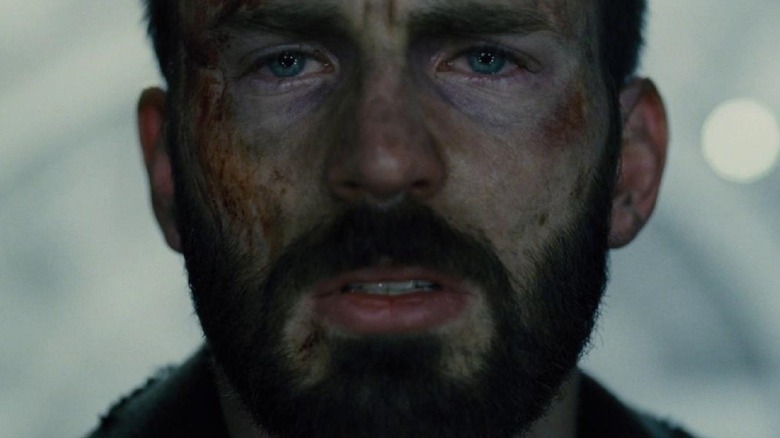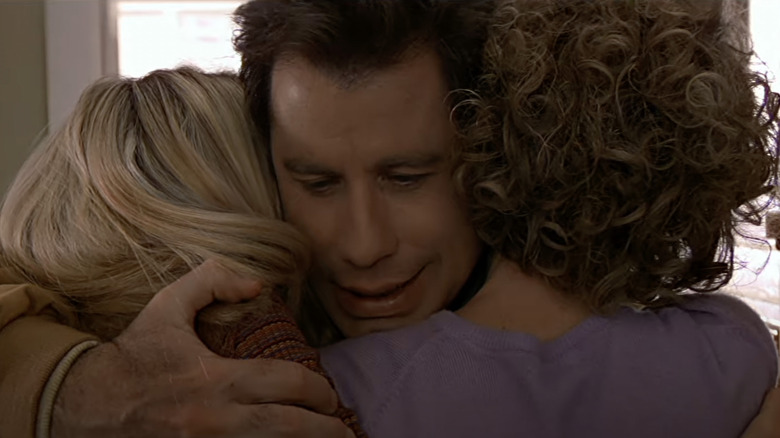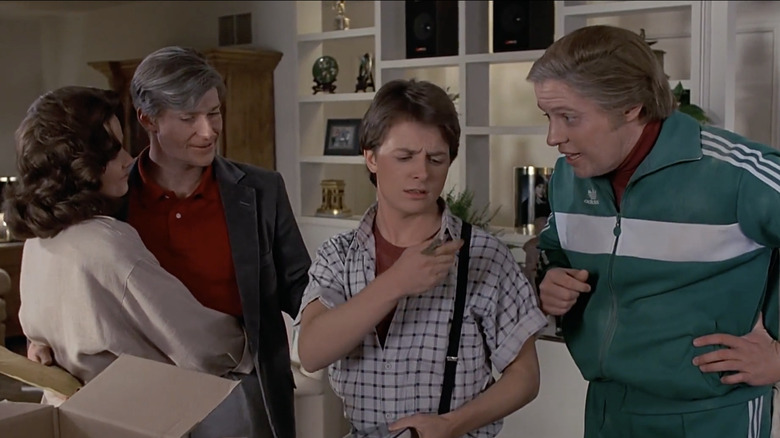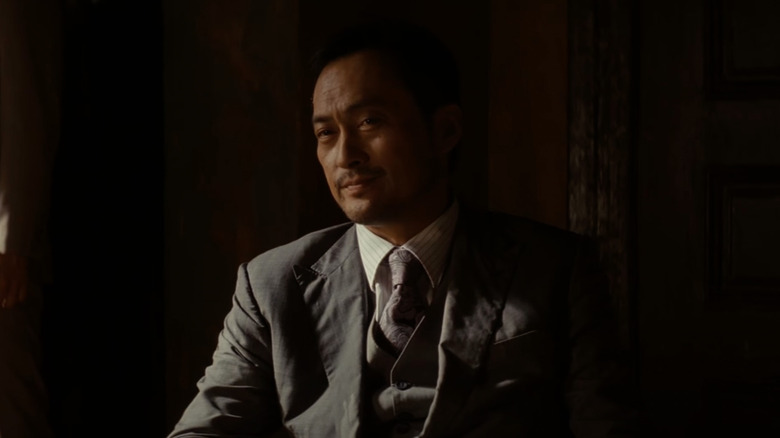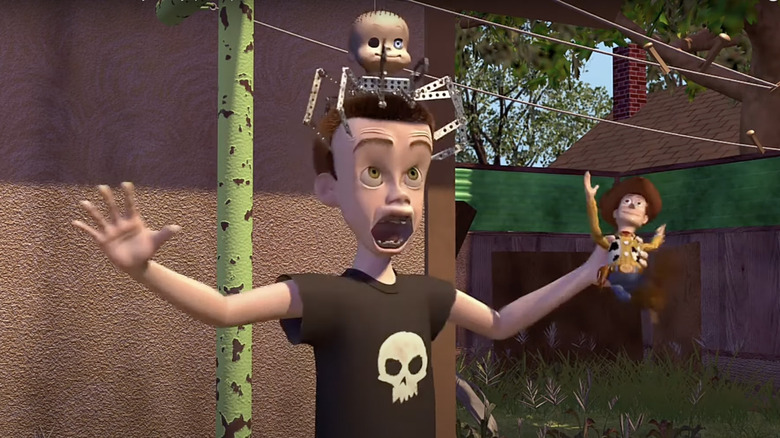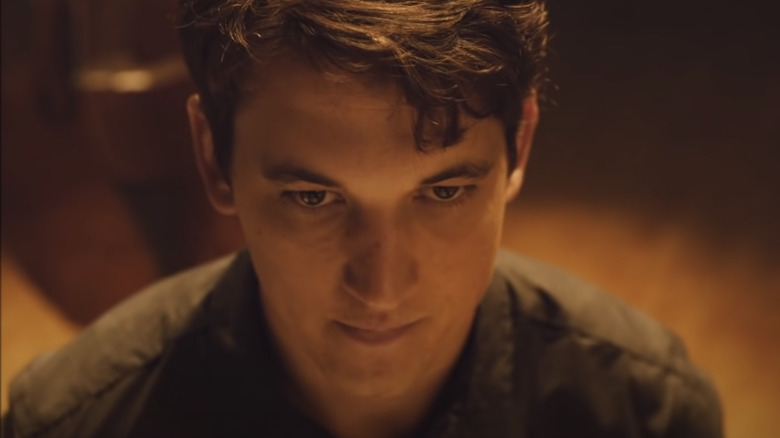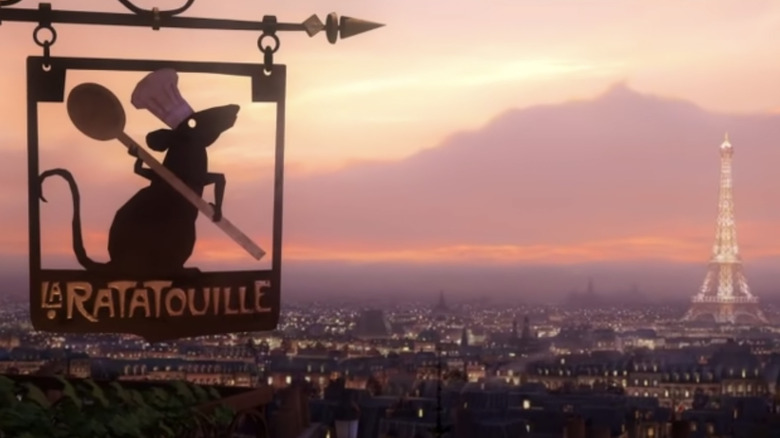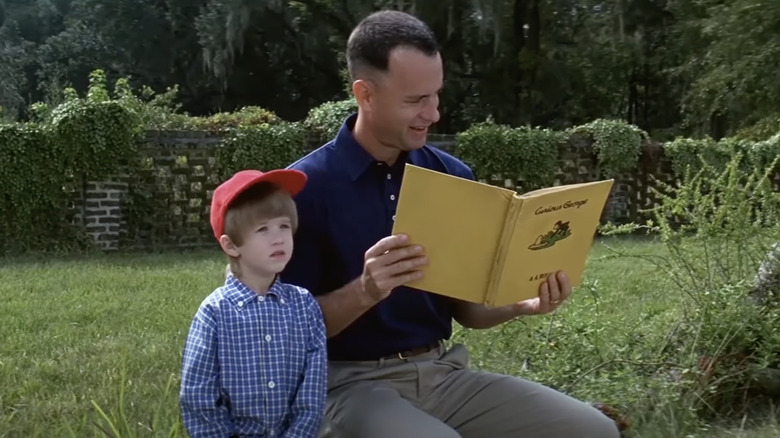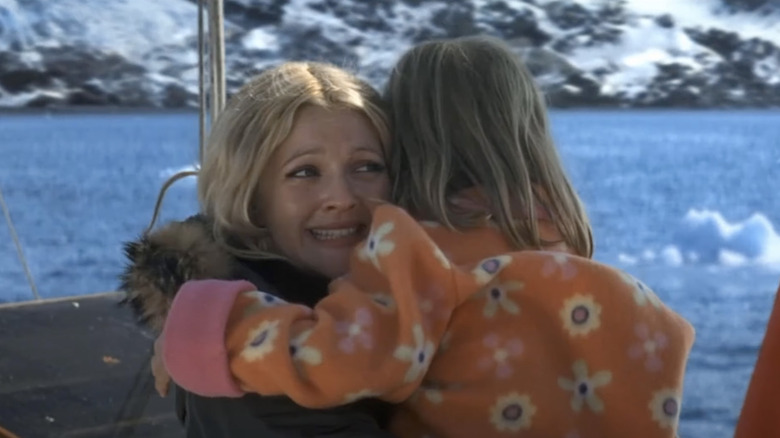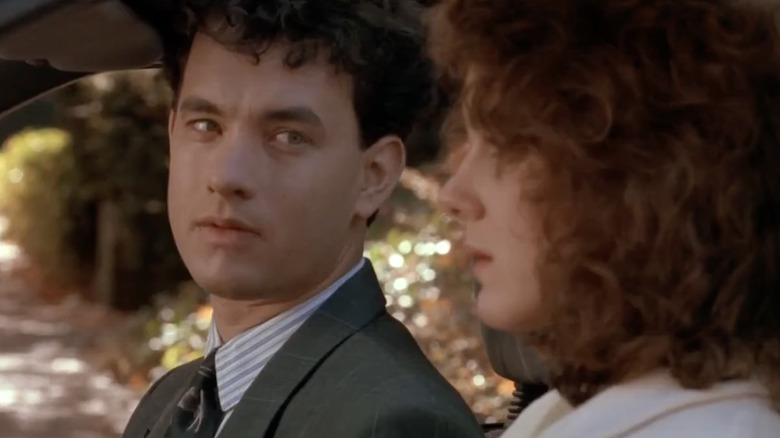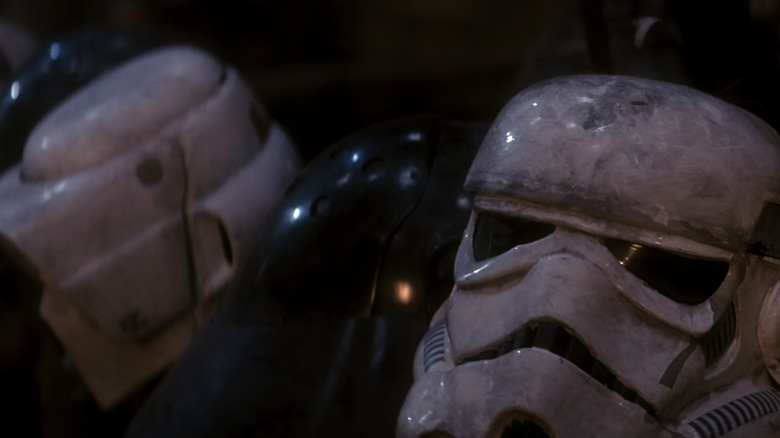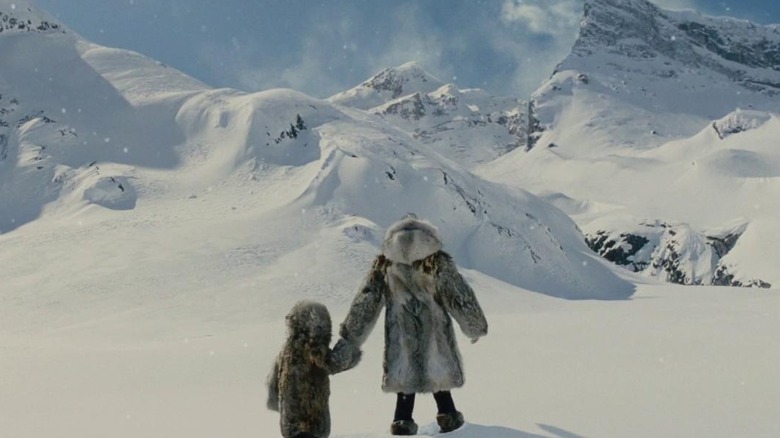Movie Endings With Troubling Implications That Slipped By You
Most of us love an upbeat ending — or at the very least, a finale with some note of triumph. It's the perfect dessert to a well-made film, satisfying our appetite for stories and leaving us with a feeling of hope. It makes total sense that so many beloved movies have happy endings. They leave audiences smiling, ensure big box office numbers, and guarantee that people will watch these films again and again.
However, there are some endings that might seem happy on the surface, but if you dig a little deeper, you'll find some unsettling ramifications that characters will have to deal with after the credits roll. Whether it's an unresolved plotline our protagonist has to face or certain factors based in reality that may not support a story's heavy-handed positivity, here are a few movies that convinced viewers their heroes will "live happily ever after," but really, these films have some troubling implications that only become apparent with age, time, and reflection.
Face/Off
John Woo's "Face/Off" circles around two characters who face off with their, well, faces off –- hence the title's double entendre. FBI agent Sean Archer holds a personal vendetta against Castor Troy, a psychopathic bomber who murdered Archer's 6-year-old son. Archer's vendetta drives him to take extreme measures to capture Troy and foil his plans, eventually leading him to undergo a temporary surgery that makes him look and sound like Troy. However, a string of unfortunate events confines Archer in the prison he was infiltrating as Troy, allowing the real Troy to adopt Archer's face and identity, moving in with his family.
As a result, Sean Archer's wife, Eve, goes through a traumatic series of events at the film's climax — finding out that she's been living with a sociopathic killer who she'd mistaken for her husband, then being held hostage by Troy who still has Sean's face, after which their daughter, Jamie, is also taken hostage by Troy-as-Sean. In the end, Sean (finally back in his own face) happily reunites with his family, but in reality, it wouldn't be easy for Eve and Jamie to immediately "unsee" Sean as the murderer and sociopath that Troy was without the help of some family counseling and therapy.
Back to the Future
At the end of "Back to the Future," Marty McFly returns from 1955 to an altered 1985 where his family's personalities have done a complete 180. His father seems to be much more confident and has built a successful writing career, his mother seems healthy and happy in her marriage, his brother has a well-paying job, and his sister has quite the active dating life.
On the surface, this seems like the best possible future for anyone to return to. However, because Marty still remembers events from the earlier timeline, his "new" family members are total strangers to him, and he'll have to deal with the knowledge of his parents' prior personalities without being able to discuss it with anybody. It's also unsettling to consider that if Marty perhaps created a new timeline, his parents in the original timeline may still be waiting for him to return without knowing that his disappearance was the result of time travel.
Additionally, the family now employs Biff as a valet, seemingly forgetting that 30 years ago, on the night of the prom dance, Biff tried to force himself onto Lorraine, and George had to save her from him. That definitely has to be an uncomfortable situation for poor Lorraine.
Inception
The central premise of Christopher Nolan's "Inception" hinges on energy tycoon Saito employing Dominick Cobb to "incept" an idea into his rival's mind, an idea that will lead him to abandon the energy industry –- effectively handing Saito a monopoly. Despite several hiccups along the way, the team is ultimately successful in persuading Saito's competitor, Robert Fischer, that dissolving his company and becoming "his own man" is what his father would've wanted.
Dealing with real-world monopolies isn't as fun or gleeful as playing the "Monopoly" board game, as a company that dominates an industry without strong competitors runs the risk of abusing its position and overly raising prices for consumers. The film establishes Saito as a ruthless and powerful businessman, with the ability to eliminate fugitive-from-the-law Cobb's "wanted" status permanently with only a phone call. The fact that someone like him would have a monopoly on something as essential and in-demand as energy would be concerning for the planet and pose a potential crisis. We can only hope that spending 50 years in limbo gave Saito some perspective, and that he'll use his influence for humanitarian causes rather than out of selfishness and greed.
Toy Story
The plot of "Toy Story" culminates with Woody and Buzz joining forces with Sid's mistreated and disfigured toys to teach the human bully a lesson on why he should be treating his toys better. As Sid is about to send Buzz, who's attached to a firework rocket, into the air, Woody speaks to Sid directly through his pre-programmed voice box –- deviating from his usual "reach for the sky" and "there's a snake in my boot" lines. This acts as a cue for Sid's toys to crawl up to him slowly in a creepy, "Night of the Living Dead" fashion, heightening Sid's horror and confusion until it reaches its apex when Woody bursts out from his "toy" form and tells Sid to "play nice." Sid screams and runs away as the toys rejoice in their newfound freedom.
While Sid getting his long-overdue comeuppance seems fitting for a children's movie, adults (many of whom first watched "Toy Story" as children themselves) can't help but notice that Sid now has to live with the guilt of literally having tortured living things. Since toys are constantly present in our culture, in every home and retail establishment, seeing a seemingly innocent little toy will most likely trigger painful reminders for him that these toy are actually sentient. What makes it worse is that Sid can't talk to anyone about it since no one would believe him, not even a mental health professional.
Whiplash
"Whiplash" tells the tale of an extremely toxic teacher-student pair who go to extreme lengths to perfect their craft and musical talents –- at the expense of their relationships, family, and their own mental health. Throughout the film, ambitious drummer Andrew Neiman relentlessly hammers towards his desire for greatness, fueled by his abrasive music teacher Terence Fletcher, neither of whom will tolerate mediocrity in their work. As a result, Andrew distances himself from his father, splits up with his girlfriend, repeatedly injures his hands from overplaying, and is involved in a near-fatal car accident before making his way to the concert.
The climactic concert sequence, in which Andrew finally earns Fletcher's nod of approval following a rigorous drum solo, gives the impression of a triumphant ending for Andrew. But with time, viewers come to see that Andrew has ultimately fallen into a deep pit of suffering and self-abuse, evident by the image of his father during the climactic sequence, who watches his son fall into a deep pit of artistic obsession. Andrew's very likely dark path after the film's events is hinted at by Fletcher's constant idolization of jazz musician Charlie Parker throughout the film, who himself had mental health issues and drug addictions (via Biography) and who died at age 34.
If you or anyone you know is struggling with addiction issues, help is available. Visit the Substance Abuse and Mental Health Services Administration website or contact SAMHSA's National Helpline at 1-800-662-HELP (4357).
Ratatouille
"Ratatouille" follows the tale of Remy the rat, the only rodent among his clan with a taste for good cuisine and culinary arts. A series of events causes Remy to get separated from his family and find himself in Paris, home to Gusteau's, the restaurant of Remy's cooking idol Auguste Gusteau. Here, he befriends the clumsy but sweet Alfredo Linguini, who Remy uses as a human conduit to channel his culinary talents –- to the point where Gusteau's regains its lost reputation and opens the door to Remy's own bistro, La Ratatouille.
Granted, a rat becoming a chef is an amusing premise for a Pixar movie ... but perhaps not so much for real life. Given that the average lifespan of a rat is 2 years — and Remy seems to be well into his adulthood — it's very likely that Remy will pass away less than a year after the film's ending. Since his newly opened bistro La Ratatouille hinges on his culinary prowess, it would be troublesome for the bistro's management and investors that its head chef wouldn't live past a year. Then again, we're talking about a rat that can cook, understand English, and can control a human being like a puppet by pulling on his hair, so maybe we can take the less pessimistic route by assuming that rats in the Pixar universe can live as long as people do.
Forrest Gump
In Robert Zemeckis' classic film, we watch as Forrest Gump's adventures take him across the globe. Despite his low IQ, he achieves fame on his football team, fights in Vietnam, plays ping-pong against Chinese teams in ping-pong diplomacy, receives the Medal of Honor from President Lyndon B. Johnson, and reports an office burglary that unfolds into the Watergate scandal. Plus, he finds himself crossing paths with the likes of Elvis Presley and John Lennon. However, it's Forrest's relationship with his childhood sweetheart, Jenny, over the course of decades that serves as the film's unifying narrative thread.
When Forrest finally catches up to Jenny at the end of the movie, she reveals that she's been infected with an "unknown virus" and that she has a son who's also named "Forrest." Jenny succumbs to her illness, which is implied to be HIV/AIDS, leaving Forrest Jr. in the care of Forrest Sr. Tragically, since HIV/AIDS can be transmitted from mother to child during pregnancy, it's possible that Forrest Jr. also carries the virus. In a 2019 interview with Yahoo! Entertainment, "Forrest Gump" screenwriter Eric Roth confirmed that the now-shelved sequel would've begun with Forrest Jr. being diagnosed with AIDS and facing discrimination in school as a result.
50 First Dates
In "50 First Dates," Drew Barrymore's Lucy struggles with a form of anterograde amnesia after an accident, preventing her from being able to create any memories. Each day is a "reset" for Lucy, who believes that it's October 13 (which was the date of her injury). Her brother and father go to considerable efforts to relive the same event for her every day and to prevent her from finding out the real date with the help of the owners of the Hukilau Cafe, which is where she meets Adam Sandler's Henry. Henry falls in love with Lucy and devises a way to help her to move on to the next day and feel like she's making progress in life by making her watch a "recap" film of her life up until the moment she wakes up.
Although the ending seems wholesome and heartening, the implications are more distressing when you really think about them. Lucy — who's revealed to have a child with Henry at the end of the film — would have had to wake up every single day for nine months not knowing she was pregnant, let alone waking up on a boat beside a stranger (Henry), who would have to keep reminding her who she is by painstakingly editing and updating her "recap" videos. Plus, with their boat offshore, Lucy is practically trapped on the vessel, even if she really needs some space for herself on days that her condition would be difficult for her to process.
Big
"Big" follows 12-year-old Josh Baskin whose wish to grow "big" comes true, as he grows into an adult body over night. Since his mother doesn't believe that this 30-year-old man is indeed her son, Josh moves to New York City and gets a entry level job at a prominent toy manufacturing company. That's where he impresses owner Mr. MacMillan with his insight into current toys and his childlike enthusiasm, and soon, he's promoted to vice president of product development.
Along the way, Josh develops a romantic relationship with co-worker Susan Lawrence, which fades away as our protagonist finds adulthood stressful and exhausting and wishes to become a child again. Despite Susan's initial disbelief, she's ultimately convinced that Josh is a child, and she bids a tearful goodbye at the end of the film as she drops him at his home.
The revelation that Josh was a 12-year-old child all along doesn't cause Susan any distress at any time during the movie's ending, which is odd, especially considering that she'd previously "spent the night" at Josh's apartment. The fact that Susan still harbors love for Josh at the end of the film and her lack of regret or revulsion over having been intimate with him all indicate something problematic about Susan's character.
Return of the Jedi
Released in 1983, "Return of the Jedi" is remembered not just for serving as the conclusion to the original "Star Wars" trilogy but also for introducing the Ewoks, the inhabitants of the moon of Endor. The fuzzy aliens join forces with the Rebels to take down the Empire's shield generator on the forested moon, opening the way for the good guys to finally destroy the Death Star. However, "Star Wars" fans continue to debate their inclusion in the movie, with some claiming that the small and furry creatures were merely introduced as lucrative merchandising opportunity to sell Ewok teddy bears and plush toys (via MTV).
But don't let their cute exteriors fool you. The Ewoks would've eaten Luke, Han, and Chewbacca had it not been for C-3PO's golden exterior and Luke's powerful Force abilities. However, this isn't the only time we get a look at the Ewoks' upsetting dietary habits. At the end of the film, amidst the celebrations at Endor after the Empire's defeat, we see a few empty Stormtrooper helmets, posing the disturbing implication that the carnivorous Ewoks may have cooked and eaten the Stormtroopers.
Snowpiercer
At the end of Bong Joon-ho's post-apocalyptic "Snowpiercer," Chris Evans' Curtis succeeds in reaching the frontmost car of the Snowpiercer train, after having battled through disheartening classism and segregation faced by passengers from the rear of the train, with each approaching car acting as classist tiers of its passengers. Up in the engine, he meets Wilford, the architect of the locomotive that houses the last of humanity's survivors in a non-habitable world. Wilford offers Curtis his position to lead the train, but Curtis is shocked by the revelation that Wilford has been using children as slaves in the engine, as they're small enough to fit in the engine compartments.
Outraged that the entire train literally runs on human suffering and knowing there's no way to fix this broken system, Curtis sets off an explosion that derails and destroys Snowpiercer. In the wake of the crash, the film closes with a polar bear spotting Yona and Timmy, the two children who are the only survivors from the crashed train and, by extension, the only remaining human beings left. They can step outside without instantly freezing to death, which — coupled with the bear sighting — gives us hope that Earth might once again be habitable. However, even if the cold weather is livable, the two children aren't shown to have any survival skills needed to exist on their own without adults, let alone hold their own against a polar bear. Chances are good they'll eventually die of either cold, starvation, or an animal attack.
